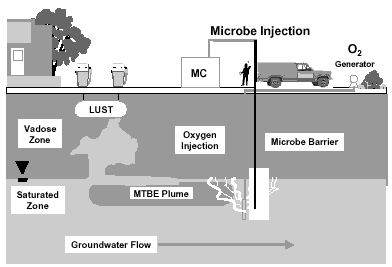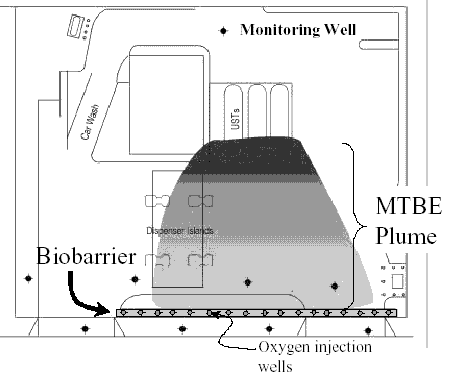Environmental Impact
Methyl-Tertiary-Butyl- Ether (MTBE) is a major pollutant in our water ways . In an
interview with Mrs. Louise Chapman, a faculty member at Mainland High School, she stated
that, "[It's] not only in surface water, but it has also made its way into the ground
water, which means that it is in our drinking water as well. This hydrocarbon is also
detrimental to organisms in the marine environment".
The sub lethal effects of MTBE were examined by conducting different tests on three
southern California
marine species. On the purple sea urchin, an embryonic development test was
conducted. On the giant kelp, a germination and growth test was conducted. On
the amphipod, a growth test was conducted. The threshold for toxic effects on the
most sensitive species, amphipod, was 37 micrograms per liter (mg/L). The least
sensitive species was the giant kelp and at 2,236 mg/L it showed a 50% reduction in
growth. The highest concentration of MTBE measured in receiving water was less than
0.1% of the threshold effects level for the amphipod. The tests above show the
effects of MTBE on organisms, but it is possible that these effects show up in animals in
Florida.
The environmental fate
and biological effects of the fuel oxygenate MTBE is of concern because it is highly
soluble in water. Little is known about the biodegradability and eco-toxicity of MTBE.
Nearly half of all watercraft and 100% of personal watercraft (PWC) are powered by
two-stroke marine engines. A single jet ski can dump up to six gallons of raw fuel
into the water during two hours of use. The Bluewater
Network estimates that two-stroke marine engines account for more than 8 million
pounds of MTBE emitted into U.S. waters annually. This amount exceeds the Environmental
Protection Agency's (EPA) total for all sources combined. The annual MTBE releases into
surface and drinking water increases exponentially each year.
MTBE lasts longer in ground water than surface water because MTBE resists degradation
in groundwater. In the air, MTBE tends to divide into atmospheric water, which
includes precipitation. The division of MTBE into precipitation inputs
up to 3 mg/L of the oxygenate into surface and groundwater.
Bans in restricted-use areas keep jet skis from operating at high speeds within a
certain distance of the shoreline, which is normally 1,200 feet. San Francisco County,
California has strong citizen support for a restricted-use area in conjunction with an
access corridor. Monroe County, Florida,
which is known as Jet Ski Nirvana, has succeeded in barring the machines from operating at
high speeds within 1,200 feet off beaches and resorts between Key Largo and Key
West. These regulations will help to keep MTBE out of the drinking water better,
even though it will be put into the surface water.
As a result of the restrictions in Monroe County, the problems seen in other states are
not yet occurring in Florida. This is primarily due to Florida's geological conditions
(a flat and shallow aquifer) and the low concentrations of MTBE in Florida's fuels.
MTBE has been tested on aquatic animals and the development tests and growth tests have
shown that animals are succumbing to the effects of MTBE being admitted into water by the
two-stroke engine powered personal watercraft. According to the EPA's standards of
pollution, Florida is in no danger of contamination. Extracting MTBE from PWC
fuel will further diminish the chances of Florida becoming poisoned with the gasoline
oxygenate.

Image courtesy of The Why Files
The Westhollow Technology Center in Houston has developed BioRemedy, a
process for treating MTBE contaminated water. This process can completely degrade
MTBE into CO2, cells, and water. It is an in situ solution, meaning that
it occurs underground, the water doesn't need to be extracted, and no wastes need to be
disposed of. BioRemedy is an "enhanced bioremediation system" that was
designed to limit the migration of MTBE plumes. An MTBE plume is the area
underground that has been contaminated. MTBE-degrading mixed cultures are added to
the soil near the leading edge of the MTBE plume, and then oxygen created biobarriers are
installed. The process by which MTBE degrades into CO2 is aerobic,
meaning that the degradation can only occur in the presence of oxygen. As ground
water travels through the treated soil and the biobarrier, the MTBE is converted into CO2.
BioRemedy
has been very successful at retail gas stations in California and the North East in
containing and mass reducing MTBE in ground water. In areas where mixed cultures and
oxygen biobarriers were implanted, the concentration of MTBE has been reduced
fourfold. Because BioRemedy is an in situ process, it has a very low visual impact,
is more cost effective, and the entire system remains active for at least a year after
being installed. |
 |

Images used with permission of BioRemedy
Researchers are attempting to remove MTBE from drinking water, which is
proving to be a difficult task because MTBE is soluble in water. On September 15,
1999, the EPA released a report
detailing the ways in which MTBE can be removed from drinking water, including air
stripping, activated carbon absorption, and advanced oxidation.
In air stripping, the MTBE-infected drinking water is pushed through
packing material in one direction while air is forced through the packing material in the
opposite direction, which volatizes the MTBE. This process is more successful in treating
benzene-infected water because of the non-polar characteristics benzene exhibits. In
addition to being ineffective, this process is also very expensive.
Activated carbon absorption is a process by which the MTBE-infected water
is pumped though a carbon filter, which is a bed of activated carbon.
Activated carbon is a
highly absorbent powdered or granular carbon used chiefly for purifying
absorption. Coconut carbon filters have been the most effective filters in reducing
MTBE concentrations in drinking water. This unique purification method was developed by Mark Stouffer.
In advanced oxidation, combinations of ultraviolet light, chemical
oxidants, and catalysts are used to transform the MTBE in water. This process has
successfully been employed in individual
homes with impacted drinking-water wells.
Eric Wilson, a sales engineer at Air and Water Quality Inc. in Windham,
ME, has been marketing carbon canisters to homeowners in areas where the water has become
contaminated. These canisters employ both air stripping and catalytic carbon
filtering, and are four cubic feet in size. In Standish, ME, they lowered the
concentration of MTBE from 6500 parts per billion to 3 parts per billion. These
canisters cost about $8,000 per unit, but if the pollution is not self-inflicted, the
state government will cover the cost.

Image courtesy of Air and Water Quality Inc.
Chemical engineer Marc Sims and molecular biologist Jim Robinson have designed PoroCrit, another
device that can be used to remove MTBE from the water supply. Porocrit was first used in
extracting food flavorings, and then Sims found that chemically MTBE was very similar to
food flavorings. The device works by running polluted water through
microporous, polypropylene tubes. The water then passes through liquid carbon
dioxide, and the MTBE dissolves in the carbon dioxide. This is because MTBE is far more
soluble in carbon dioxide than it is in water. PoroCrit works best with small
amounts of contaminated water in which MTBE concentrations are high. This means that
PoroCrit would be most effective if used where MTBE enters the water source, for example,
near gasoline stations. Sims and Robinson also found PoroCrit effective in removing other
gasoline compounds from the drinking water.
John Bowser
of Compact Membrane Systems, Inc received a grant for $70,000 from the National Center for
Environmental Research to develop more ways to remove MTBE from drinking water. The
duration of this grant was for six months. He focused on the removal of MTBE from water for small-scale operations either as a stand-alone technique or one that is
easily integrated into existing facilities. Mr. Bowser and CMS built a MTBE
disinfecting system, which is a novel synergistic technology to destroy MTBE into carbon
dioxide and water. His main objective was to demonstrate the synergy between the two
main components involved in the degradation of MTBE. Mr. Bowser's objective was met,
and he had encouraging results. Mr. Bowser's preliminary results indicate the
success of his technology, which effectively demonstrated degradation of MTBE in water at
concentration levels ranging from 50-600 ppmv.
While there are many clean up processes and products on the market, none of them would
be effective in cleaning up the MTBE emitted by two-stroke engines in PWC. This is
because none of these methods can cost effectively be used on our recreational waterways
without further disrupting, and in some cases further, damaging, the environment.